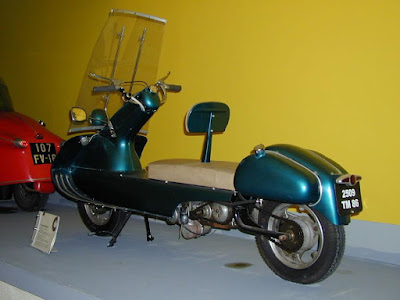ONE-OFF In its development after World War II, in France had ever developed a two-wheeled vehicle style called a mauto (two-wheeled car). This style presented a unique scooter figure made by Armand Pagnon, a railcars development engineer worked for Renault. In his spare time, he built this mauto-style scooter by his-owned hand in his Nancy-located garage in 1955.
 |
| 1955 Pagnon Mauto unique scooter built by Armand Pagnon while sat on display at the Auto Motocycle Museum, the French's Châtellerault-located bicycles, motor-cars, motor bikes and scooters museum. (Picture from: Stabilcar) |
Actually, there's no official name for the scooter model, however here we will refer to it as the Pagnon Mauto (as a homage to its maker). After completion of construction, then the scooter was shown on display and presented to the public for the first time at the 1957 Salon de l'Automobile de Paris (Paris Auto Salon).
 |
| 1955 Pagnon Mauto unique scooter has been designed in such a way with a high windshield and proper front shield that the rider and passenger (if any) are effectively protected of the wind and rain exposure. (Picture from: Stabilcar) |
This Pagnon Mauto has been designed in such a way that the rider and passenger (if any) are effectively protected of the wind and rain exposure. This is because the the scooter design adopts a unique appearance with a seating position in short distance from the floor, coupled with a high windshield and proper front shield.
 |
| The sketch of the Pagnon Mauto with a
125 cc two-stroke engine from Ultima (Lyon), which is coupled with a
4-speed manual transmission system which is operated through the
right-handlebar. (Picture from: Stabilcar) |
For the bodywork of this unique scooter, Pagnon then gave the to the Eslassant company that specializes in the production of racing cars by using the moulding machine. The Pagnon-made scooter is powered a 125 cc two-stroke engine from Ultima (Lyon), which is coupled with a 4-speed manual transmission system which is operated through the right-handlebar. |
| 1955
Pagnon Mauto unique scooter adopted a rear wheel drive system with universal joint of cardan types, and what makes it at glance similar to a car. (Picture from: Stabilcar) |
The scooter adopted a rear wheel drive system with universal joint of cardan types, and what makes it at glance similar to a car. And for its suspension system, in the front with the thrust wheels and Neiman ring. While in the rear features a deformable parallelogram and a triple of Neiman rings. And the steering is moved to the back by a cardan coupling as well. There is something confusing about the scooter riding, when you turn the handlebar to the right, it leans to the left (considered could be dangerous).
 |
1955 Pagnon Mauto unique scooter powered by two-stroke engine from Ultima (Lyon), which is coupled with a
4-speed manual transmission system which is operated through the
right-handlebar. (Picture from: Alienor.Org)
|
This may be due to the fork designs so that movement is transmitted to the handlebars with a cardan clutch, but most importantly, if we believe the sketch published by the "scooter review", this fork hunt is not a good fit. However this did not prevent Armand Pagnon, the builder from taking the Metz-Paris trip to present the scooter at the 1957 Paris Motor Show along with his brother as a passenger in the back. |
| This three-wheeled vehicle had a similar design to the scooter mentioned before and also designed by Armand Pagnon. (Picture from: Stabilcar) |
Besides
designed and built this unique scooter like the one above, it turns out
that Armand Pagnon also had time to design (only on paper) a three-wheeled
vehicle had a similar design to the scooter above (called the Tri-Pagnon), but until
today never been made into real one.
This prototype is the only scooter made by Armand Pagnon, and after several decades it was restored by Yves Dumez, who later in the 1999 sold it to the Auto Motocycle Museum, the French's Châtellerault-located bicycles, motor-cars, motor bikes and scooters museum.
That's it, and if the article above is still considered inadequate or inaccurate, or if you have additional information relate to the Pagnon Mauto, please don't hesitate to let us know via the comments column below this article.
Kept spur your adrenaline on the power of the two-wheeled monster and stay alive with true safety riding. May God will forgive Your sins and so does the cops.....
*** [EKA | FROM VARIOUS SOURCES | STABILCAR | ALIENOR.ORG ] Note: This blog can be accessed via your smart phone









































